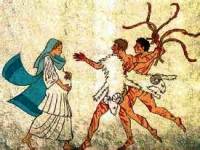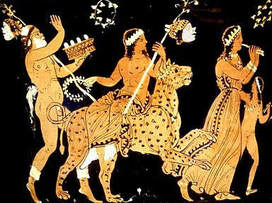When wandering through the greeting card section looking for the perfect card to give your loved one for Valentine’s Day, have you ever wondered about the origin of the traditional heart shape associated with love … and, therefore, Valentine’s Day?
The heart shape itself has been around forever. It appears in the cave-wall drawings of cro-magnon hunters, as far back as the ice age. Also, the shape itself is frequently seen in nature, so the question isn’t where the shape came from, but how it became the symbol of love and Valentine’s Day.
Ivy Leaf

The origins of Saint Valentine's day are rooted in the ancient Romans and their fertility festival of Lupercalia on the Ides of February (15th), dedicated to Faunus, the Roman god of agriculture. It was a sensuous affair where young women put their names in a big pot and young men simply drew out a name. According to Glenn Church's 2008 article, "The man did not need to ask for a date, plan a dinner setting or a movie. Just draw a name and off to fornicate."

The Pope’s action toned down the festivities but, according to scholar Noel Lenski, University of Colorado, “It was a little more of a drunken revel, but the Christians put clothes back on. That didn’t stop it from being a day of fertility and love.”
Ah-ha! So the connection to love (fertility rites, anyway) wasn’t St. Valentine, but the pagan festival his name day superseded. Or was it?
WHO WAS SAINT VALENTINE?
Actually, no one knows for sure, but historians agree there was nothing romantic in any of the histories of the three early-Christian martyrs (Saints) named Valentine. To complicate things, two of the Saint Valentines were executed on February 14 but in different years of the third century. Saint Valentine of Rome

Apparently, records of these events, if there were any, have been destroyed and references to the Saint and his legend come in documents written much later than the third century. Valentine of Rome was executed by the emperor between 269 and 273 (references vary), and is most likely the Saint Valentine being honored. Whether or not the legends are true, who knows?
THE SHAPE OF VALENTINES TO COME
Getting back to the point, when did the heart shape become identified with love. I went in search of the real answer which, of course, doesn't exist … or at least no one agrees on the subject, but there are a number of intriguing theories.
♥ Dionysus and the Leopard’s Spots
Chronologically speaking, the first theory is the heart shape originated as the symbol of Dionysus, Greek god of grapes, wine, and debauchery, and champion of sexual orgies. The god and the Cult of Dionysus are depicted among Mycenaean artifacts the end of the Bronze Age (1600-1100 BC).
By the seventh century BC, Dionysus was well established in the beliefs of the time. His symbols include the bull, serpent, and tiger, as well as grapes, wine, and ivy. He is often depicted riding a leopard, wearing a leopard skin, and carrying the thyrsus -- a long stick or wand topped with a pinecone -- and wearing an ivy crown.

In my humble opinion, this theory is a real stretch. Supposedly, the god’s favorite leopard skin had a spot which was the exact shape of a heart. I’m going to cross this one off the books. If anything, it was the crown of ivy he wore that associated him with the heart shape.
♥ The Abortive Qualities of Silphium
At about the same time, the seventh century BC, the city-state of Cyrene (a Greek, and later Roman) city near present-day Shahhat, Lybia was known to trade in the rare, and now extinct, plant silphium.
Silphium, a well-known herb widely use in the Mediterranean area for spicing food, grew only along the Libyan coast where the climate is now considerably drier. It was also widely used as an abortive agent for women. The day after sex, the woman would eat the silphium plant or its seeds and usually abort.
And guess what? Its seeds were shaped like hearts. The plant was commemorated on Cyrene coins, such as the ones shown below, because of its economic importance to the city-state. It's quite plausible the shape of the seed pod became related to sexuality and love because of this major use as an abortive.



 RSS Feed
RSS Feed